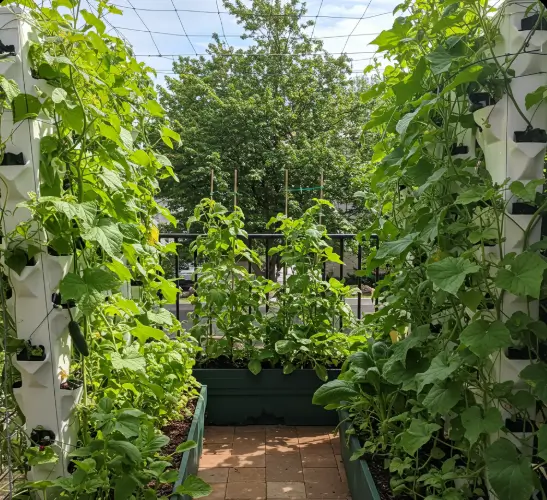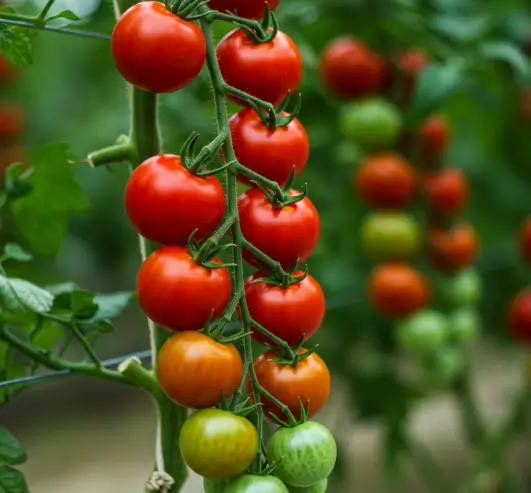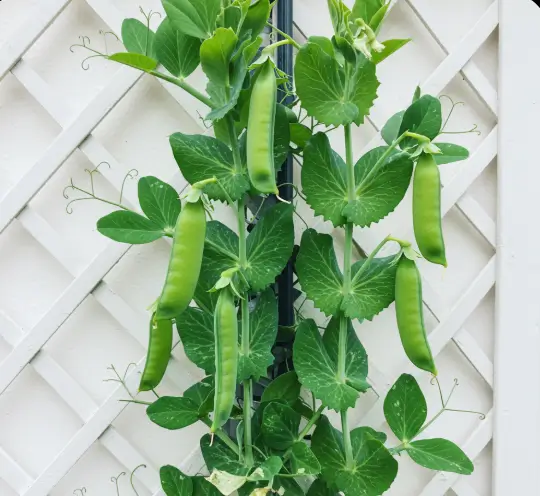Introduction
As a child, I spent much of my time in my grandmother’s garden. It was her little sanctuary, filled with vibrant rows of tomatoes, cucumbers, and other vegetables that seemed to stretch upwards towards the sky. Her garden was always a place where I learned the value of fresh produce, but more importantly, it taught me about the potential for gardening, even in the smallest spaces.
This love for growing my own food continued to develop over time, especially when I found myself living in an apartment with limited outdoor space. That’s when I first turned to vertical gardening as a solution. Vertical gardening, which uses structures like trellises, towers, and other supports to grow plants upwards, can transform small spaces into lush, productive gardens.
Choosing the right vegetables for vertical gardening is essential to ensuring that the space is used effectively. Not all vegetables are suited to being grown vertically, so understanding which plants are ideal for this method is crucial. In this article, I will share with you the best vegetables for vertical gardening and provide tips on how to make the most of your space.
Table of Contents
Understanding Vertical Gardening
Definition and Principles of Vertical Gardening
Vertical gardening is a method of growing plants in a vertically stacked manner rather than sprawling them horizontally on the ground. This technique can include the use of trellises, cages, towers, and other support structures that allow plants to grow upwards. This approach is particularly useful for maximizing space, especially in urban environments or areas where space is limited.
The basic principle of vertical gardening is to encourage plants to grow upward instead of outward. This method has been gaining popularity due to its numerous advantages, such as better air circulation, higher yields in smaller spaces, and reduced pest pressure.
Advantages of Vertical Gardening in Limited Spaces
For those with small yards, apartments, or urban environments, vertical gardening is a game-changer. Here’s why:
- Optimizes small spaces: Vertical structures allow you to grow more plants in compact areas, making them perfect for urban gardening.
- Better light exposure: Vertical gardens allow plants to receive more sunlight by positioning them in areas with optimal exposure, such as walls or fences.
- Improved air circulation: Plants grown in vertical gardens experience better airflow, which can reduce the risk of fungal diseases.
- Easier maintenance: Growing vertically makes it easier to manage your plants without bending down, which is particularly helpful for people with mobility issues.

Key Considerations Before Starting a Vertical Garden
Before diving into vertical gardening, there are several factors to consider:
- Weight capacity: Ensure that the structures you use are strong enough to hold the weight of your plants as they grow.
- Sunlight: Most vegetables need at least six hours of sunlight per day. Choose a spot that receives the most sunlight.
- Watering system: Watering can be tricky for vertical gardens, especially in elevated planters. Think about setting up a drip irrigation system to water more efficiently.
- Choosing the right plants: Some vegetables aren’t ideal for growing vertically. Focus on climbing varieties that naturally grow upwards.
Criteria for Selecting Vegetables for Vertical Gardening
Growth Habits Conducive to Vertical Cultivation
When selecting vegetables for vertical gardening, it’s important to choose those with growth habits that lend themselves to vertical growth. Climbing plants or those that can be trained to grow upwards are the best candidates. Tomatoes, cucumbers, and beans are natural climbers and will flourish in vertical gardens when given the right support.
Space Efficiency and Yield Considerations
In a vertical garden, space is at a premium. It is essential to select vegetables that provide high yields relative to their space. Some vegetables, like tomatoes or peas, offer consistent harvests throughout the growing season, making them ideal for vertical cultivation.
Additionally, consider plants that are compact but productive, like leafy greens or herbs. These can be grown in stacked vertical planters, offering continuous harvests with minimal space requirements.
Climate and Environmental Factors
Your local climate plays a significant role in determining which vegetables will thrive in a vertical garden. For instance, tomatoes and cucumbers need plenty of sunlight and warmth, so they should be grown in areas with sufficient heat. Conversely, peas and leafy greens can tolerate cooler conditions, making them ideal for cooler climates or shaded areas.
Top Vegetables for Vertical Gardening
In this section, I will explore the best vegetables for vertical gardening, including their benefits, growing requirements, and tips for vertical cultivation.
Tomatoes
Tomatoes are a popular choice for vertical gardening. Varieties like cherry and grape tomatoes are particularly well-suited to grow vertically, as they are smaller and more compact than larger tomato varieties.
Support structures and training methods:
- Tomato cages or A-frame trellises are ideal for supporting tomato vines. These structures help the plants grow upwards while providing stability as they mature.
- Regular pruning and tying the vines to the support structure will help the plant grow tall and healthy.
Common challenges and solutions:
- Blossom end rot: This can be caused by inconsistent watering or a calcium deficiency. To avoid this, ensure even moisture levels and add calcium supplements to the soil.
- Pests: Aphids and tomato hornworms are common pests. Use organic pest control methods like neem oil to manage these issues.

And for more advice about tomatoes, check our article (click here )
Cucumbers
Cucumbers are another excellent vegetable to grow vertically. Their vining nature makes them well-suited for vertical supports like trellises or mesh netting.
Trellising techniques and support systems:
- Use A-frame trellises or netting systems to allow the cucumber vines to grow upwards.
- It’s essential to secure the vines regularly to prevent them from sprawling out of control.
Pest and disease management:
- Powdery mildew is a common issue in cucumber plants. Ensure proper air circulation and water the base of the plant rather than the leaves.
- Cucumber beetles can be controlled with organic insecticidal soap or by handpicking them off the plant.
Pole Beans
Pole beans are one of the best vegetables for vertical gardening due to their natural climbing ability. They provide consistent yields throughout the growing season, making them an ideal choice for vertical gardens.
Ideal support structures for climbing:
- Use teepee-style trellises made from bamboo or wooden stakes to support pole beans.
- Beans are heavy feeders, so be sure to amend the soil with compost to provide necessary nutrients.
Harvesting tips for continuous production:
- Harvest beans regularly to encourage continuous production. Beans that are left on the vine too long will reduce the overall yield.
Peas
Peas are another vertical gardening favorite. Varieties like sugar snap peas and snow peas are perfect for growing on trellises or mesh netting.
Constructing pea trellises:
- A simple trellis made of string or wire can support peas as they climb. Raising the plants off the ground helps lower the chances of rot.
- Companion planting with beans or other legumes can help fix nitrogen in the soil, benefiting all plants in the garden.
Implementing Vertical Gardening Structures
Vertical gardening requires the right supports to ensure your plants grow effectively. The structure you’ll need depends on the vegetables you’ve decided to cultivate.
Types of Vertical Supports (Trellises, Cages, Towers)
- Trellises are simple, vertical frames made of wood, metal, or mesh that allow plants to climb.
- Cages are often used for tomatoes and other bushy plants, providing support while keeping the plants contained.
- Towers are ideal for compact vegetables like strawberries or smaller tomato varieties and can be used to grow multiple plants in a small footprint.
DIY vs. Commercial Options
Many gardeners choose to build their vertical garden supports using materials like wood or bamboo. This approach allows for customization and can be more cost-effective. However, pre-made options such as metal trellises or vertical garden towers are also available for those who prefer convenience.
Installation tips:
- Ensure that your supports are sturdy and securely anchored to prevent collapse as plants grow.
- Place structures in areas that receive adequate sunlight and provide space for proper plant growth.
FAQ Section:
What vegetables are best suited for vertical gardening?
The best vegetables for vertical gardening are those that naturally climb or vine. Some of the most suitable vegetables include:
- Tomatoes (especially smaller varieties like cherry and grape tomatoes)
- Cucumbers
- Pole Beans
- Peas
- Melons (small-fruited varieties)
- Zucchini and Squash (trained upwards)
- Leafy Greens like lettuce, spinach, and kale
- Herbs such as basil, parsley, and thyme
- Peppers (bell peppers and chilies)
- Strawberries (grown in towers or hanging baskets)
These vegetables are perfect for vertical gardening due to their climbing nature or ability to be trained to grow upward with the help of trellises or other support systems.
How do I support vegetables in a vertical garden?
Supporting vegetables in a vertical garden depends on the type of plant you’re growing. Common support structures include:
- Trellises: Vertical structures like wire or wooden trellises support climbing plants such as cucumbers, peas, and tomatoes.
- Cages: Tomato cages are great for bushy plants like tomatoes, providing vertical support as the plants grow.
- Towers: Vertical towers can be used for vegetables like strawberries, providing space for multiple plants in a compact area.
- A-frame supports: These structures are ideal for climbing plants like pole beans and peas.

Choosing the right support structure is essential for ensuring your plants grow healthily and remain upright as they mature.
Can leafy greens be grown vertically?
Yes, leafy greens such as lettuce, spinach, and kale are excellent candidates for vertical gardening. These plants thrive in small spaces, making them well-suited to vertical planters or wall gardens.
- Succession planting is a useful technique for ensuring a continuous harvest of leafy greens.
- These plants generally require less sunlight than fruiting vegetables, making them ideal for shaded or partially shaded vertical gardens.
- Regular watering is essential, and vertical systems with drip irrigation are especially useful for maintaining consistent moisture levels.
What are the challenges of vertical vegetable gardening?
While vertical gardening is incredibly rewarding, there are several challenges you may face:
Sunlight: Vertical gardens may not always receive the best sunlight, especially if they are located in shaded areas. It’s essential to place your vertical garden where it will get sufficient sunlight, or consider supplemental lighting if you are gardening indoors.
Watering: Watering can be tricky in vertical gardens, especially if you’re using elevated containers. Ensuring that each plant gets enough water without overwatering is key. Installing a drip irrigation system is a good solution.
Structural stability: As plants grow and produce fruit, they can become heavy. It’s important to use strong, stable support structures (like sturdy trellises, cages, or towers) to ensure that they don’t collapse under the weight of the plants.
Pest and disease management: Vertical gardens may be more exposed to pests and diseases, particularly aphids, snails, or mildew. Regular inspection and organic pest control methods, such as neem oil or insecticidal soap, will help manage these issues.
Reflecting on Vertical Gardening
Vertical gardening offers a fantastic opportunity to grow fresh, nutritious vegetables even in small spaces. By selecting the right vegetables and setting up proper supports, you can maximize your gardening potential. Whether you are growing tomatoes, cucumbers, or leafy greens, vertical gardening allows you to make the most of your space and enjoy the rewards of homegrown food. Experiment with different vegetables and structures to find what works best for you, and remember to enjoy the process of growing your own garden!

2 thoughts on “Best Vegetables for Vertical Gardening: A Complete Guide”